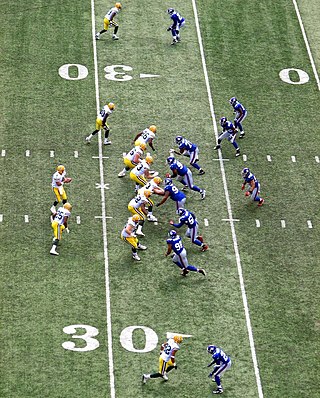
The shotgun formation is a formation used by the offensive team in gridiron football mainly for passing plays, although some teams use it as their base formation. Instead of the quarterback receiving the snap from center at the line of scrimmage, in the shotgun he stands farther back, often five to seven yards off the line. Sometimes the quarterback will have a back on one or both sides before the snap, while other times he will be the lone player in the backfield with everyone spread out as receivers.

In gridiron football, a lineman is a player who specializes in play at the line of scrimmage. The linemen of the team currently in possession of the ball are the offensive line, while linemen on the opposing team are the defensive line. A number of NFL rules specifically address restrictions and requirements for the offensive line, whose job is to help protect the quarterback from getting sacked for a loss, or worse, fumbling. The defensive line is covered by the same rules that apply to all defensive players. Linemen are usually the largest players on the field in both height and weight, since their positions usually require less running and more strength than skill positions.
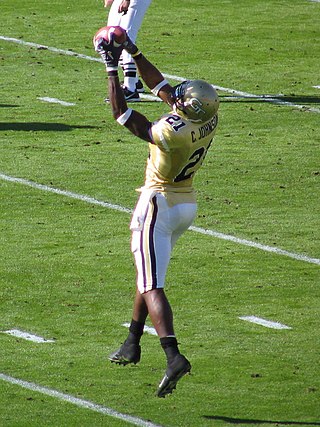
A wide receiver (WR), also referred to as a wideout, and historically known as a split end (SE) or flanker (FL), is an eligible receiver in gridiron football. A key skill position of the offense, WR gets its name from the player being split out "wide", farthest away from the rest of the offensive formation.
Strategy forms a major part of American football.

The 46 defense is an American football defensive formation, an eight men in the box defense, with six players along the line of scrimmage. There are two players at linebacker depth playing linebacker technique, and then three defensive backs. The 46 defense was originally developed and popularized with the Chicago Bears by their defensive coordinator Buddy Ryan, who later became head coach of the Philadelphia Eagles and Arizona Cardinals.
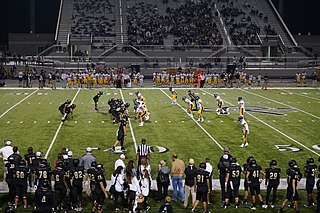
In American football, the pro set or split backs formation is a formation that has been commonly used as a "base" set by professional and amateur teams. The "pro set" formation features an offensive backfield that deploys two running backs aligned side-by-side instead of one in front of the other as in traditional I-formation sets. It was an outgrowth of the three-running-back T-formation, with the third running back in the T becoming a permanent flanker, now referred to as a wide receiver.
A formation in American football refers to the position players line up in before the start of a down. There are both offensive and defensive formations and there are many formations in both categories. Sometimes, formations are referred to as packages.

The I formation is one of the most common offensive formations in American football. The I formation draws its name from the vertical alignment of quarterback, fullback, and running back, particularly when contrasted with the same players' alignments in the T formation.

In American football, a T formation is a formation used by the offensive team in which three running backs line up in a row about five yards behind the quarterback, forming the shape of a "T".

In American football, the specific role that a player takes on the field is referred to as their "position". Under the modern rules of American football, both teams are allowed 11 players on the field at one time and have "unlimited free substitutions", meaning that they may change any number of players during any "dead ball" situation. This has resulted in the development of three task-specific "platoons" of players within any single team: the offense, the defense, and the so-called 'special teams'. Within these three separate "platoons", various positions exist depending on the jobs that the players are doing.

The triple option is an American football play used to offer six ways to move the football forward on the field of play. The triple option is based on the option run, but uses three players who might run with the ball instead of the two used in a standard option run.

The spread offense is an offensive scheme in gridiron football that typically places the quarterback in the shotgun formation, and "spreads" the defense horizontally using three-, four-, and even five-receiver sets. Used at every level of the game including professional, college, and high school programs across the US and Canada, spread offenses often employ a no-huddle approach. Some implementations of the spread also feature wide splits between the offensive linemen.
In American football, a play is a close-to-the-ground plan of action or strategy used to move the ball down the field. A play begins at either the snap from the center or at kickoff. Most commonly, plays occur at the snap during a down. These plays range from basic to very intricate. Football players keep a record of these plays in a playbook.
The pistol offense is an American football formation and strategy developed by coaches Michael Taylor of Mill Valley, California and popularized by Chris Ault when he was head coach at the University of Nevada, Reno. It is a hybrid of the traditional shotgun and single back offenses. In the pistol offense, also commonly referred to as the "pistol formation", the quarterback lines up four yards behind the center, which is much closer than the seven-yard setback in a traditional shotgun formation. The running back then lines up three yards directly behind the quarterback, which is in contrast to the shotgun, where they are beside each other. It is argued that the position of the quarterback in the pistol formation strikes an advantageous compromise: the quarterback is close enough to the line of scrimmage to be able to read the defense, as with run situation sets such as the I formation, but far enough back to give him extra time and a better vision of the field for passing plays, as in the shotgun. The pistol formation is thus very versatile, particularly if the quarterback himself is a threat to run the ball, which makes it difficult for the defense to correctly anticipate the play. This flexibility is enhanced by the option, where the quarterback reads one or more defenders and reacts to their responses to the snap, then makes a rapid decision whether to hand off the ball to the running back or keep it and run himself.
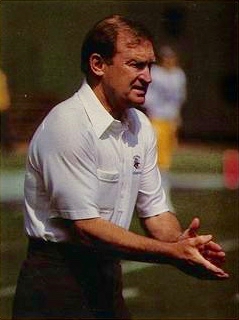
In American football, Air Coryell is the offensive scheme and philosophy developed by former San Diego Chargers coach Don Coryell. The offensive philosophy has been also called the "Coryell offense" or the "vertical offense".
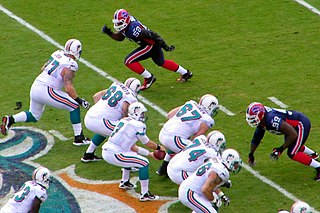
A pro-style offense in American football is any offensive scheme that resembles those predominantly used at the professional level of play in the National Football League (NFL), in contrast to those typically used at the collegiate or high school level. Pro-style offenses are fairly common at top-quality colleges but much less used at the high school level. The term should not be confused with a pro set, which is a specific formation that is used by some offenses at the professional level.
The following terms are used in American football, both conventional and indoor. Some of these terms are also in use in Canadian football; for a list of terms unique to that code, see Glossary of Canadian football.
In American football, a back is a player who plays off of the line of scrimmage. Historically, the term "back" was used to describe multiple positions on offense and defense, although more descriptive and specific position naming is now common. Thus, "back" can refer to positions including:
The run and shoot offense is an offensive system for American football which emphasizes receiver motion and on-the-fly adjustments of receivers' routes in response to different defenses. It was conceived by former high school coach Glenn "Tiger" Ellison and refined and popularized by former Portland State offensive coordinator Mouse Davis.














